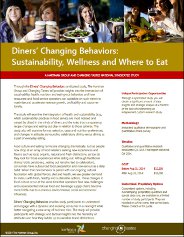Sustainable food service: bending food-consumption behavior
 A not-so-quiet revolution driven by consumers’ pursuit of fresh, less processed foods has been overtaking the once seemingly unassailable marketing-based regimes of legacy food, beverage, restaurant and food service brands, from Coca-Cola to McDonald's to Budweiser. There’s been an acute rise of alternatives that some consumers see as healthier and higher quality, often heralded in headlines trumpeting the success of Boston Beer, Panera Bread, Trader Joe's, Subway, Starbucks, Chipotle Mexican Grill and many others.
A not-so-quiet revolution driven by consumers’ pursuit of fresh, less processed foods has been overtaking the once seemingly unassailable marketing-based regimes of legacy food, beverage, restaurant and food service brands, from Coca-Cola to McDonald's to Budweiser. There’s been an acute rise of alternatives that some consumers see as healthier and higher quality, often heralded in headlines trumpeting the success of Boston Beer, Panera Bread, Trader Joe's, Subway, Starbucks, Chipotle Mexican Grill and many others.
A similar and often overlooked revolution — rooted in the social and cultural demand for fresh, healthier, more sustainable food experiences — is developing within American schools, universities and diverse institutional food service settings.
Food service is an increasingly vibrant segment of food culture that’s training diners to eat in ways that we are just beginning to comprehend. The effect is a significant bending of food-consumption behavior. But because food service is less about branding than it is about the food itself, its efforts are less publicly celebrated than companies with big marketing budgets and media attention.
Obtain insights into the intersection of sustainability, health, nutrition and eating-out behaviors and how restaurant and food service can capitalize on such trends to maximize and accelerate revenue growth, profitability and customer loyalty.

Download study overview and participation form
Aside from the meteoric time frame in which public schools, higher education and workplaces have recast “cafeteria food,” what is perhaps most interesting about the demand for fresher foods in institutional food settings is the notion that industry terms like sustainability, obesity and wellness are harmonizing with consumer desires for fresh, local and natural and forming a hotbed of emerging food experiences.
Some signs of such culturally driven changes:
- In 2013, the U.S. Department of Agriculture’s first Farm to School census found that 44 percent of public school districts reported having farm-to-school programs in place; an additional 13 percent committed to launching such a program in the near future.
- At the “Tastes of the World Chef Culinary Conference” at UMass Amherst this summer, food service chefs and other culinary professionals shared success stories and recipes from college campuses and other food service venues — all reflecting a shift toward fresh, authentic and full-flavored cuisines. (Read more about The Hartman Group’s visit here )
- At a recent 2014 Menus of Change conference hosted by the Culinary Institute of America and Harvard School of Public Health, leaders from the restaurant, institutional food service and public health sectors discussed ways to improve the health of Americans as well as the planet. Three primary issues were discussed: the influence of climate change on global food sourcing, finding more sustainable and creative ways to source and serve proteins, and how to increase consumption of fruits and vegetables.
The Menus of Change conference highlighted how sustainable efforts that are real and measureable are being undertaken in food systems that serve millions of meals a year across restaurant and institutional settings. Bret Thorn, a reporter for Nation's Restaurant News, wrote:
“Foodservice operators also pointed to progress at their venues. Jayne Buckley, vice president for strategic business implementation at Compass Group North America, said she was being pushed by clients such as Google and Microsoft, who are demanding that their plates be half covered with fruits and vegetables, as recommended by the U.S. Department of Agriculture. Jeff Miller, vice president of product innovation and executive chef of Dunkin’ Brands Group Inc., parent company of Dunkin’ Donuts and Baskin-Robbins, said he found success introducing produce in a way that intersects with his customers’ lifestyle. For example, Dunkin’ Donuts introduced a portable egg white omelet with turkey sausage and spinach on flatbread. ‘We didn’t try to change behavior to [buying] salad through the drive-thru,’ he said. Instead, he gave them options that dovetailed well with their demands.” (Nation’s Restaurant News, June 11, 2014).
The rise of fresh and less processed, so apparent in the blockbuster success of brands like Trader Joe’s, Panera Bread and Chipotle Mexican Grill, has created a halo that to consumers today signifies high quality as well as health and sustainability. The pursuit of that halo is now diffusing from supermarket aisles into a host of restaurant formats.
Institutional food service is also changing in step with food culture, yet at the same time further understanding is needed about how sustainability, health and nutrition influence consumers in all eating-out occasions and settings.
For example, with all the cultural energy emanating from both emerging restaurant formats and progressive school and food service menus, questions arise like:
- What’s the role of sustainability in diners’ decisions about where and what to eat today?
- Which sustainability practices in food service and restaurant operations are most noticed and valued by diners?
- What’s the consumer response to sustainable and healthy shifts made in ingredients and menu design?
Participate in the Diners’ Changing Behaviors: Sustainability, Wellness and Where to Eat syndicated study. Download study overview and participation agreement form.
